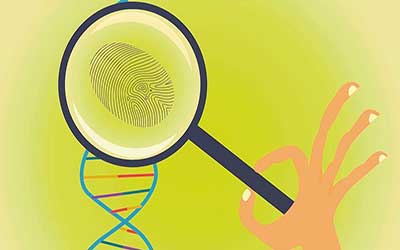Date: 17/05/2023
Relevance: GS-2 and GS-3: Judiciary and its functioning; Awareness in the fields of Biotechnology
Key Phrases: DNA technology, Rahul v. the State of Delhi 2022, Manoj v. State of Madhya Pradesh (2022), Careful sampling, Ethylene Diamine Tetra Acetic Acid, RT-PCR, Short Tandem Repeats, Random match probability, DNA matching, random occurrence ratio, clinching evidence, DNA expert’s report.
Why in News?
- The use of DNA technology in criminal investigations and trials has become an important tool for forensic evidence.
- However, in its recent judgments, the Supreme Court has been critical of admitting DNA reports as clinching evidence in criminal cases.
Judgments:
- Rahul v. the State of Delhi, Ministry of Home Affairs (2022):
- The Court said, “The collection and sealing of the samples sent for examination were not free from suspicion.”
- It objected to the fact that the Delhi High Court and the trial court did not examine the underlying basis of the findings in the DNA report and also did not examine whether the expert reliably applied the techniques.
- Based on this reason, despite the ‘match’ result of the DNA analysis, and other findings, the Court acquitted all three persons who were accused of rape and murder.
- Manoj v. State of Madhya Pradesh (2022):
- The expert explained the technique of DNA analysis but did not mention the ‘random occurrence ratio,’ the Court held that there was a likelihood of contamination as one of the reference samples was collected from an open area.
Careful sampling is a must:
- Biological samples must be dried at room temperature and sealed in a paper bag to avoid contamination from plastic.
- Contamination from humic acid in the soil must be avoided, and areas with potential DNA evidence should not be touched, talked over, or coughed/sneezed upon.
- Stained articles should be packed separately, and liquid blood samples should be collected using blood collection cards or EDTA (Ethylene Diamine Tetra Acetic Acid) vials in a vaccination box with coolants.
- The investigating officer should maintain proper custody of the sample and ensure that it reaches the forensic science laboratory (FSL) within the stipulated time period.
- The Union Home Ministry has provided sexual assault evidence collection kits to all States with blood collection cards and EDTA vials for proper sample collection and preservation.
Analysis of DNA Material:
- Extraction of DNA Material:
- The first step in FSL is to extract DNA material from a sample by separating other elements such as RNA, proteins, lipids, cell debris, and humic acid.
- Automated machines are now used to extract DNA from biological material depending on low and high copy numbers of DNA for further analysis.
- Quantification of DNA Material:
- The next step is the quantification of the extracted DNA material using the RT-PCR machine.
- Further analysis is carried out irrespective of the number of copies found during quantification.
- Amplification and STR Typing:
- Once the quality and quantity of the sample are known, the sample is subjected to amplification by Short Tandem Repeats (STR) typing using the PCR machine.
- STR typing means to mark locations that identify uniqueness and are different in every individual.
- The PCR products are separated using automated genetic analysers, and the results are compared with the provided referral sample.
- Results Interpretation:
- The obtained STR profile may be from a single source or a mixed profile obtained mostly in evidence of sexual assault cases.
- If the sample size and quality are good enough to reach a ‘match’ result, it cannot be said that the sample might be contaminated.
- Had the sample been sufficiently contaminated, the ‘match’ result would not have arrived.
- The result is interpreted as match (inclusion) or not-match (exclusion) or inconclusive (only when a partial DNA profile is generated).
- Random match probability:
- The Court has questioned the forensic expert for not mentioning the ‘random occurrence ratio’.
- This statistical ratio or ‘random match probability’ (RMP) is referred to as the frequency of the particular DNA profile in a population.
- A small RMP value means the profile is rare in the population and vice versa.
- The Central FSL, Directorate of Forensic Sciences, released a Working Procedures Manual Forensic DNA Testing in 2019, which prescribes the procedure for calculating RMP for automated STRs.
- Therefore, there is no justifiable reason for a DNA expert not to mention RMP in its report.
Chain of Custody:
- The chain of custody is important in ensuring that the DNA evidence is reliable.
- The Court has questioned the collection and sealing of the samples sent for examination, and whether the expert reliably applied the techniques.
- Therefore, it is important to maintain a proper chain of custody of the samples from collection to analysis and presentation in court.
Conclusion:
- The use of DNA reports as evidence in court cases requires careful sampling, proper extraction, and analysis, along with the mention of RMP in the DNA report.
- The forensic expert must reliably apply the techniques, and standard guidelines need to be established for admitting DNA reports as credible evidence.
- The criminal justice system must be sensitized to the techniques of DNA analysis to ensure justice is served.
- As the evidence of DNA matching in criminal cases, particularly those based on circumstantial evidence, acquires great importance, some standard guidelines need to be laid down by the Court for admitting the DNA expert’s report as credible evidence.
Source: The Hindu
Mains Question:
Q. Discuss the role of DNA evidence in criminal cases and the Supreme Court's recent criticisms of the admission of DNA reports as clinching evidence. What are the standard guidelines that need to be laid down for the admission of DNA reports as credible evidence?







